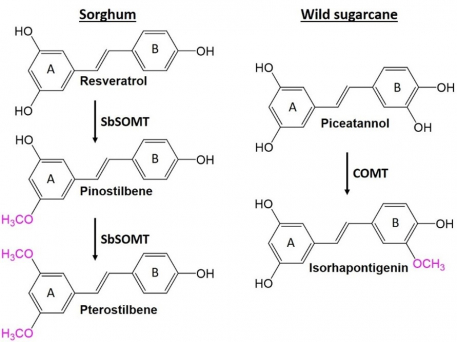China (University of Hong Kong) New Enzyme Discovered by HKU Plant Biochemists Unlocks Potential for Health-Promoting Compounds in Sorghum

Stilbenes are natural compounds found in various plants that have shown potential health benefits for humans, with a unique chemical structure consisting of two aromatic rings linked by a double bond. While resveratrol, found in grapes and red wine, is the most well-known stilbene, there has been increasing interest in other types of stilbenes that could offer additional health benefits.
O-methylated stilbenes, which are produced by introduction of a methyl group (-CH3) to a hydroxyl (-OH) group on the stilbene backbone, are promising compounds for research. Some plant species, such as sorghum and wild sugarcane, have been found to produce different types of O-methylated stilbenes in response to abiotic or biotic stress and may have greater potency and bioavailability than non-methylated stilbenes. This makes these plant species particularly interesting for research on the biosynthesis of O-methylated stilbenes and potential applications in developing functional foods, nutraceuticals, and pharmaceuticals.
Recently, a research team led by Dr Clive LO from the School of Biological Sciences at The University of Hong Kong (HKU) collaborated with laboratories at the University of Queensland (UQ), Australia, and the HKU School of Biomedical Sciences (SBMS), as well as scientists in Mainland China and Japan, to discover a novel stilbene O-methylase (SbSOMT) in sorghum, an enzyme which is responsible for catalyzing the production of O-methylated stilbenes. The discovery offers a new avenue for producing O-methylated stilbenes in larger quantities and at lower costs, which could lead to the development of new functional foods, nutraceuticals, and pharmaceuticals that harness the potential health benefits of these compounds. The research findings have recently been published in Nature Communications.
Background
Stilbenes are natural compounds found in plants with promising nutraceutical properties, known to provide a range of health benefits such as anti-ageing, anti-neurodegeneration, anti-diabetes, and chemo-preventive properties. O-methylation is a chemical process that can significantly enhance the potency and bioavailability of stilbenes. However, the biosynthesis of O-methylated stilbenes has not been well-studied, and further research is needed to generate specific stilbene compounds.
The research team conducted a study that showed how sorghum and wild sugarcane could produce different types of O-methylated stilbenes, such as pinostilbene, pterostilbene and isorhapontigenin. They used advanced genetic techniques, including CRISPR-Cas9 mutagenesis and sorghum transformation, to identify the key enzyme, SbSOMT, that mediates the specific chemical modification of stilbene called 3,5-bis-O-methylation in sorghum. This modification affects the biological activity of the stilbene, including its antioxidant and anti-inflammatory properties.
The team also conducted phylogenetic analysis to study the evolutionary relationships between different organisms, and found that SbSOMT is unique to Sorghum plants and originated from a group of related proteins called caffeic acid O-methyltransferases (COMTs) commonly found in all other grasses. In addition, the team presented the first crystal structure for SbSOMT in collaboration with HKU SBMS protein structural biologists.
Research Significance
The researchers discovered that SbSOMT uses a chemical reaction similar to COMTs in the grass family, but it binds to the stilbene molecule differently. This different binding mode allows SbSOMT to modify the stilbene molecule in a specific way that produces different types of O-methylated stilbenes in sorghum. These different types of stilbenes are characterized by the location of the O-methyl group on the stilbene molecule, either on the A-ring or the B-ring.
In sorghum, SbSOMT modifies stilbenes in a way that produces A-ring O-methylated stilbenes, such as pinostilbene and pterostilbene. Meanwhile, wild sugarcane uses a common COMT enzyme to modify stilbenes to produce B-ring O-methylated stilbenes, such as isorhapontigenin. The difference between the A-ring and B-ring O-methylated stilbenes is due to the specific way that SbSOMT interacts with the stilbene molecule, which involves the hydrophobic Ile144 and Phe337 residues in the SbSOMT enzyme.
The research has found that sorghum and wild sugarcane can potentially be used to produce O-methylated stilbenes. These compounds have health benefits and can be used in nutraceuticals (which are like dietary supplements). The team also discovered the enzymes responsible for producing these compounds in these plants.
Their findings suggest that we could use molecular breeding and transgenic approaches to create specific types of O-methylated stilbenes with even more health benefits. This could open up new possibilities for creating healthier food and supplement options.
This research was supported by the Hong Kong Research Grants Council.
The HKU Libraries Open Access Author Fund provided support for the publication.
